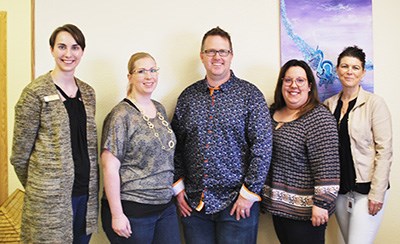By Mary Moffat
On Friday, April 13 a diverse group of people gathered in the Sustainability Project office to hear and take part in the discussion regarding the efforts of the Reducing Isolation of Seniors Collective. Headed up by Dr. Chad Nilson, a Researcher, Evaluator and Advisor from Living Skies Centre for Social Inquiry, it also included Michel Sorenson (Saskatchewan Seniors Mechanism), Abby Wolfe (Alzheimer Society Saskatchewan and Shawna Green from the Canadian Red Cross.
Nilson spoke of taking an elder shopping in a remote community and upon returning home, thought that would be a wonderful way to help a senior he knew. Off he went shopping and filled her pantry, only to realize that by doing so he had robbed her of her daily shopping trip, causing isolation. During the discussion of things that can cause isolation in Seniors, one participant quoted a family member who said “There is a disease going around; it’s called loneliness.”
This theme carried on throughout the day, as each presenter shared the efforts their group was taking to combat that disease. Abby Wolfe spoke of dementia related changes in behavior and cognitive abilities that included being unable to sit still and making rude comments, rather than memory loss, which caused the person to become isolated because people didn’t understand it was due to Alzheimer’s and didn’t know how to react to those changes. Other causes of isolation included finding yourself alone due to having your loved one in the nursing home or passed away; alone without transportation; no family close by; not living in an age-friendly community; lack of social outings caused by well meaning family members who took over those tasks to help out, to name just a few.
The Saskatchewan Seniors Mechanism is part of a worldwide initiative headed by the World Health Organization to help build age friendly communities. An age friendly community enables people of all ages to participate in community, be treated with respect and allows everyone to age in place. Several ages can benefit from the same changes in a community, such as repairing a torn up sidewalk will benefit a senior with a walker, but also a young parent pushing a stroller. Outdoor spaces and buildings; sidewalks; lighting; transportation; community health services and housing are all important parts of an age friendly community. Social participation is also important, while a Facebook page may reach many people, posters in local stores and restaurants will help to reach those others not using social media.
Shawna Green of the Canadian Red Cross – Friendly Visiting Program matches Red Cross Volunteers with people aged 65 and up for either phone or personal visits. Given that by 2036 seniors will make up 25% of the population and isolation can be as harmful as a ½ pack of cigarette habit, it is a program that is much needed. Their goal is to provide adults with social connections that make them feel safe remaining in their home, and can be as simple as the volunteer visiting weekly or biweekly or a morning and evening wellness check phone call. Keep an eye on the paper for further information on a group being set up in this area.
Abby Wolfe of the Alzheimer Society drew attention to the fact that 60% of people with Alzheimer’s or dementia live in their homes but only 50% have an actual diagnosis. Their goal is to reduce stigma and help people to understand the need for diagnosis, which in turn leads to better of the disease. A better understanding of the disease, which affects abilities, behavior and communication, and/or memory will help to reduce isolation of those people diagnosed and their families as well.




